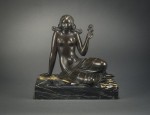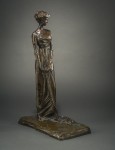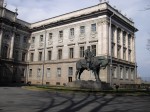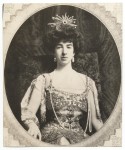 Two bronze sculptures that were stolen from the Hirschl & Adler Gallery in New York in December of 1983 have been found and returned to the gallery. Central Figure of Day by Paul Manship was the first to be stolen from the gallery in broad light on December 3rd, 1983. Three weeks later, Figure of Gertrude Vanderbilt Whitney by Prince Paul Troubetzkoy was stolen again in the middle of the day. The thefts were reported to the Art Dealers Association of America (ADAA) at the time but the case soon went cold.
Two bronze sculptures that were stolen from the Hirschl & Adler Gallery in New York in December of 1983 have been found and returned to the gallery. Central Figure of Day by Paul Manship was the first to be stolen from the gallery in broad light on December 3rd, 1983. Three weeks later, Figure of Gertrude Vanderbilt Whitney by Prince Paul Troubetzkoy was stolen again in the middle of the day. The thefts were reported to the Art Dealers Association of America (ADAA) at the time but the case soon went cold.
 Last December, both sculptures were consigned for sale by a private collector to the Gerald Peters Gallery. He had owned them since 1985 when he bought them together from a shop in New York’s diamond district. The collector no longer had receipts nor remembered which store he had purchased them from. In advance of their exhibition and sale, the Gerald Peters Gallery did due diligence research into the ownership history of the sculptures and discovered they were stolen property. It then hired Art Recovery International to negotiate between the parties and arrange for the return of both pieces. Two months later on February 6th, 2015, the works were returned to Hirschl & Adler.
Last December, both sculptures were consigned for sale by a private collector to the Gerald Peters Gallery. He had owned them since 1985 when he bought them together from a shop in New York’s diamond district. The collector no longer had receipts nor remembered which store he had purchased them from. In advance of their exhibition and sale, the Gerald Peters Gallery did due diligence research into the ownership history of the sculptures and discovered they were stolen property. It then hired Art Recovery International to negotiate between the parties and arrange for the return of both pieces. Two months later on February 6th, 2015, the works were returned to Hirschl & Adler.
The legal process of determining ownership in this case presented very few obstacles. Unlike the legal systems in most European counties, it is a basic tenet of US law that no individual can obtain good title to a stolen work of art – not even when purchased in good faith. The law recognises that a stolen work of art is always stolen property and therefore makes no exceptions for good faith, passage of time or the number of owners since the theft occurred.
It helped that Hirschl & Adler had retained full documentation of their ownership of the statues and of the theft, so there was no question of who held the last legal title. The collector who has owned them for 30 years is not considered a suspect. He just spotted a bargain in a shady store.
Ray Lazerson, Treasurer at Hirschl & Adler Gallery, commented: “There can’t be too many dealers who have to tell their gallery Director twice in three weeks that something has been stolen! We are delighted that these works have been found and grateful for the co-operation of all parties in their recovery.”

 Both sculptors are famous for monumental outdoor works: Manship for his 1934 gilded statue of Prometheus overlooking the Lower Plaza of Rockefeller Center and Troubetzkoy for his 1909 equestrian statue of Tsar Alexander III of Russia now in front of the Marble Palace in St. Petersburg. Indeed, Central Figure of Day was done in a similar style to Prometheus, during a period when Manship became fascinated by ancient sculpture after he won the Rome Prize and attended the American Academy on residential fellowship from 1909 until 1912. He also became interested in Indian art at this time, an influence you can see in Central Figure of Day.
Both sculptors are famous for monumental outdoor works: Manship for his 1934 gilded statue of Prometheus overlooking the Lower Plaza of Rockefeller Center and Troubetzkoy for his 1909 equestrian statue of Tsar Alexander III of Russia now in front of the Marble Palace in St. Petersburg. Indeed, Central Figure of Day was done in a similar style to Prometheus, during a period when Manship became fascinated by ancient sculpture after he won the Rome Prize and attended the American Academy on residential fellowship from 1909 until 1912. He also became interested in Indian art at this time, an influence you can see in Central Figure of Day.
 Figure of Gertrude Vanderbilt Whitney was one of a number of sculptures Prince Troubetzkoy made for high society figures of the golden age. Mrs. Whitney was one of the most notable. A succesful sculptor in her own right as well as a society maven, philanthropist and patron of the arts, she is best remembered today as the founder of the Whitney Museum of American Art which she established in 1931 to showcase the works of living American artists who had been rejected by more hide-bound institutions like the Metropolitan Museum of Art.
Figure of Gertrude Vanderbilt Whitney was one of a number of sculptures Prince Troubetzkoy made for high society figures of the golden age. Mrs. Whitney was one of the most notable. A succesful sculptor in her own right as well as a society maven, philanthropist and patron of the arts, she is best remembered today as the founder of the Whitney Museum of American Art which she established in 1931 to showcase the works of living American artists who had been rejected by more hide-bound institutions like the Metropolitan Museum of Art.
The Whitney is opening in a new building come May 1st. It would be cool if they acquired the sculpture of their founder in time for the reopening. Troubetzkoy’s bronzes rarely appear on the market, and since this one is believed to have been cast during his lifetime, it is particularly valuable. Together both pieces are valued at around $250,000 now, an exponential growth from their estimated worth of $24,000 each in 1983.